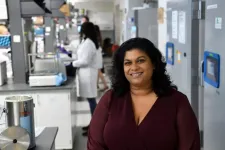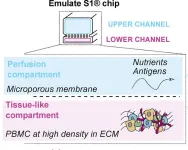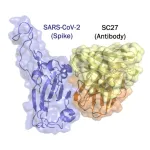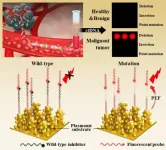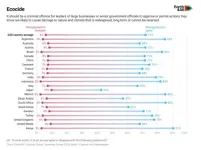(Press-News.org) Age-related changes in the fibroblasts, cells that create the skin’s structure, contribute to the development of aggressive, treatment-resistant melanoma in males, according to research in mice by the Johns Hopkins Kimmel Cancer Center.
The study was published online Sept. 6 in Cell.
The risk of developing melanoma, a potentially deadly skin cancer, increases with age. Men are more at risk than women, and tend to develop more aggressive, hard-to-treat melanomas, particularly at advanced ages, says Ashani Weeraratna, Ph.D., the Bloomberg Distinguished Professor, E.V. McCollum Professor, and chair of the Department of Biochemistry and Molecular Biology at Johns Hopkins. The study was co-led by Yash Chhabra, Ph.D., who is now an assistant professor at Fox Chase Cancer Center in Philadelphia.
Weeraratna and colleagues have demonstrated that age-related changes in the normal cells around tumor cells — the tumor microenvironment — contribute to cancer outcomes. So, they wanted to find out if age- and sex-related changes might interact to contribute to sex-linked disparities in melanoma.
“Melanoma is far more aggressive in men than women,” Weeraratna explains. “Do normal cells around the tumors age differently in men versus women?”
Fibroblasts make collagen, a protein that gives the skin structure and strength. In previous research, Weeraratna and colleagues showed that age-related changes in fibroblasts promote the spread of melanoma tumor cells and lead to worse outcomes. Now, they confirm that fibroblasts age differently in men and women, and the age-related changes that occur in male fibroblasts contribute to more aggressive, hard-to-treat melanomas.
When they transplanted melanoma tumor cells into aged male or female mice, they found more DNA damage accumulated in cells transplanted in the male mice. It didn’t matter whether the transplanted tumor cells came from male or female mice.
“It’s not the male or female tumor cell itself,” she explains. “Age-related changes in male fibroblasts that make up the tumor microenvironment account for differences in DNA damage.”
In experiments comparing aged human male and female fibroblasts, they discovered that the male fibroblasts accumulated reactive oxygen species that stress and damage cells. They also found that the aged male fibroblasts produce higher levels of bone morphogenic protein 2 (BMP2), a protein usually involved in development of bone and cartilage.
Ramping up BMP2 production using either genetic or recombinant protein approaches causes melanoma cells to become more invasive and resistant to targeted anticancer therapies. Blocking BMP2 production using a natural inhibitor makes them more sensitive to anticancer therapies in both male and female mice.
The study has significant implications for cancer research. Currently, most preclinical cancer studies use young mice. However, Weeraratna shows that studying cancer in older mice and aging human cells is essential.
“We also need to understand whether men and women respond differently to therapies, and better tailor their therapy to both sex- and age-related differences,” she says.
Weeraratna and her team are now studying how age- and sex-related changes in immune system cells surrounding melanoma cells affect how well the tumors respond to immune cell-boosting therapies increasingly used to treat melanoma. They would also like to study age- and sex-related changes in other cancers, including pancreatic cancer.
The study’s other authors include Sneha Pramod, Daniel J. Zabransky, Vania Wang, Agrani Dixit, Ruzhang Zhao, Edwin Kumah, Megan L. Brezka, Kevin Truskowski, Asmita Nandi, Gloria E. Marino-Bravante, Alexis E. Carey, Naina Gour, Devon A. Maranto, Murilo R. Rocha, Elizabeth I. Harper, Justin Ruiz, Evan J. Lipson, Elizabeth M. Jaffee, Kristin Bibee, Joel C. Sunshine and Hongkai Ji of Johns Hopkins; Mitchell E. Fane of Fox Chase Cancer Center in Philadelphia; and Laura Hüser of Johnson & Johnson. Fane and Hüser were at Johns Hopkins at the time the study was conducted.
This study and its authors are supported in part by Johns Hopkins, the National Cancer Institute (grants P30CA00697356, P01CA114046, U01CA227550, R01CA232256 and R01CA207935), the National Institutes of Health (grant 5T32CA009071-40), the Howard Hughes Medical Institute, Conquer Cancer Foundation Young Investigator Award, the Cholangiocarcinoma Foundation Research Fellowship, MD Anderson GI SPORE Career Enhancement Program, a Maryland Cancer Moonshot Grant to Johns Hopkins, and the Dermatology Foundation. Ji and Zhao are supported by Deutsche Forschungsgemeinschaft (DFG) and a Team Science Award from the Melanoma Research Alliance.
Weeraratna serves on reGAIN Therapeutics’ board. Jaffee reports grants, support or fees from Abmeta, Genocea, Achilles, DragonFly, Candel Therapeutics, the Parker Institute, Lustgarten, Genentech, AstraZeneca and Break Through Cancer. Johns Hopkins has received grants from Roche/Genentech on behalf of Zabransky. These relationships are being managed by The Johns Hopkins University in accordance with its conflict-of-interest policies.
END
Age-related changes in male fibroblasts increase treatment-resistant melanoma
2024-09-06
ELSE PRESS RELEASES FROM THIS DATE:
COVID-19 and rates of cancer diagnosis in the US
2024-09-06
About The Study: This population-based cross-sectional study of U.S. cancer incidence trends found that rates of diagnosis improved in 2021 but continued to be lower than expected, adding to the existing deficit of diagnosed cases from 2020. Particular attention should be directed at strategies to immediately increase cancer screenings to make up lost ground.
Corresponding Author: To contact the corresponding author, Krystle A. Lang Kuhs, PhD, MPH, email krystle.kuhs@uky.edu.
To access the embargoed study: Visit our For The Media website at this link https://media.jamanetwork.com/
(doi:10.1001/jamanetworkopen.2024.32288)
Editor’s Note: Please see ...
New research from Swansea University shines a light on how solar power and farming can coexist
2024-09-06
Scientists from Swansea University have developed a new tool to help identify optimal photovoltaic (PV) materials capable of maximising crop growth while generating solar power.
In a recent study published in Solar RRL, academics from the University’s Department of Physics have been exploring the effect of semi-transparent PV materials placed over crops – an exemplary application of agrivoltaics (solar panels combined with agricultural settings).
As part of this work, the team has developed an innovative freeware tool that predicts the light transmission, absorption, and power generation of different PV materials nearly anywhere on the globe using ...
Artificial lymphoid organs could help predict efficacy of booster vaccines
2024-09-06
Researchers at the Institut Pasteur in France have developed artificial “lymphoid organ-chips” that recreate much of the human immune system’s response to booster vaccines. The technology, described in an article to be published September 6 in the Journal of Experimental Medicine (JEM), could potentially be used to evaluate the likely effectiveness of new protein and mRNA-based booster vaccines for COVID-19 and other infectious diseases.
The rapid mutation and evolution of SARS-CoV-2 and other viruses ...
One antibody to neutralize them all?
2024-09-06
SAN ANTONIO -- A monoclonal antibody appears effective at neutralizing the numerous variants of SARS-CoV-2, as well as related viruses in animals that could pose a threat if they were to begin spreading in people. The antibody, called SC27, was recently described in Cell Reports Medicine.
The finding opens the possibility of broader, more effective treatments to work against current and future COVID variants.
Monoclonal antibody SC27 was identified, developed and provisionally patented by a team of researchers led ...
How context-specific factors control gene activity
2024-09-06
Every cell in our body contains the same DNA, yet liver cells are different from brain cells, and skin cells differ from muscle cells. What determines these differences? It all comes down to gene regulation; essentially how and when genes are turned on and off to meet the cell’s demands. But gene regulation is quite complex, especially because it is itself regulated by other parts of DNA.
Gene regulators: Enhancers, transcription factors
There are two important components that control gene regulation: the first are enhancers, which are short bits of DNA that increase the likelihood that a ...
Detects cancer genes with ultra-high sensitivity!
2024-09-06
Dr. Min-young Lee and Dr. Sung-gyu Park of the Advanced Bio and Healthcare Materials Research Division at KIMS have developed a technology that can detect cancer mutant genes in blood with the world's highest sensitivity of 0.000000001% based on plasmonic nanomaterials for optical signal amplification. The team tested blood samples from lung cancer patients (stages 1-4) and healthy individuals for EGFR mutations and achieved a diagnostic accuracy of 96%.
Previously utilized genetic analysis technologies had low analytical sensitivity to detect mutated genes compared to normal genes, making it difficult to accurately diagnose early-stage cancer patients. ...
Study suggests US droughts, rainy extremes becoming more severe
2024-09-06
COLUMBUS, Ohio – Severe drought in the American Southwest and Mexico and more severe wet years in the Northeast are the modern norm in North America, according to new research – and the analysis suggests these seasonal patterns will be more extreme in the future.
The middle of the United States, meanwhile, can expect bigger swings between wetter wet periods – high-rainfall years known as pluvials – and drier summers through the rest of this century, the study predicts.
Researchers at The Ohio State University say the findings, based on modern precipitation data, historical tree rings and climate models ...
Quality assurance in histopathology laboratories
2024-09-06
The medical field is inherently susceptible to errors, with laboratory tests being no exception. In histopathology laboratories, where tests are considered the gold standard for diagnosing various diseases, errors can significantly impact patient outcomes. Quality Control (QC) and Quality Assurance (QA) programs are essential in minimizing these errors and ensuring the generation of accurate and reliable reports. The complex, multistep nature of histopathology work, combined with the subjective nature of many diagnostic interpretations, ...
Causing environmental damage should be a criminal offense, say 72% of people surveyed in G20 countries
2024-09-06
Nearly three out of four people (72%) surveyed across 18 G20 countries1 support making it a criminal offence for government or leaders of large businesses to approve or permit actions which cause serious damage to nature and climate, finds major new research. This finding is part of the latest Global Commons Survey 2024, conducted by Ipsos UK and commissioned by Earth4All and the Global Commons Alliance (GCA).
The research follows recent landmark legislative changes, including in Belgium where ecocide was recognised as a federal crime earlier this year. Related laws ...
Natural probiotic discovered in UK newborns microbiomes
2024-09-06
Newborn babies have one of three pioneer bacteria in their gut shortly after birth, one of which could be used to develop new personalised infant therapeutic probiotics, researchers show.
In the largest study of UK baby microbiomes to date, researchers from the Wellcome Sanger Institute, University College London (UCL), and the University of Birmingham, used whole genome sequencing to analyse stool samples from 1,288 healthy infants, all under one month old from the UK Baby Biome Study1.
This research, published today (6 September) ...
